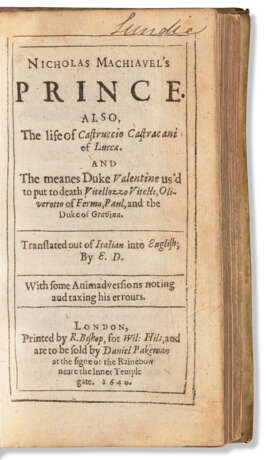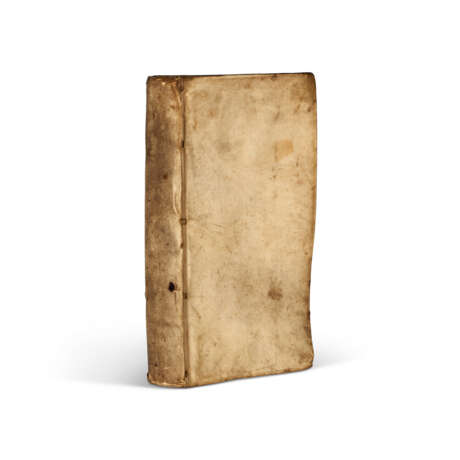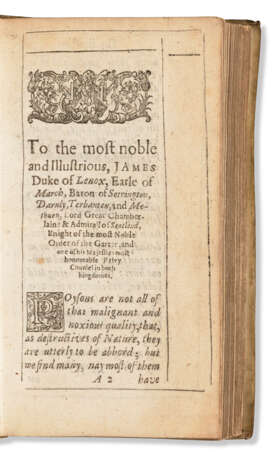ID 813779
Lot 27 | Machiavelli's The Prince
Valeur estimée
$ 70 000 – 100 000
Translated by Edward Dacre, 1640
MACHIAVELLI, Niccolo (1469-1527). Nicholas Machiavel's Prince. Also, The life of Castruccio Castracani of Lucca. And the meanes Duke Valentine us'd to put to death Vitellozzo Vitelli, Oliverotto of Fermo Paul, and the Duke of Gravina. Translated by Edward Dacres. London: R. Bishop for William Hils and Daniel Pakeman, 1640.
First edition in English of the Renaissance political masterpiece—an extremely fine and unsophisticated copy in a contemporary binding. "The Prince is far more than a book of directions to any one of the many Italian princelings. Machiavelli had profited by his journeys to France and Germany to make the most able analyses (in his reports to his government) of a national government, and he now wrote for the guidance of the ruler by whom alone Italy, desperately divided, could be restored to political health … Many of the remedies he proposed for the rescue of Italy were eventually applied. His concept of the qualities demanded from a ruler and the absolute need of a national militia came to fruition in the monarchies of the seventeenth century and their national armies" (PMM).
Although the text began to circulate in the early 16th century, it did not see print (in Italian) until 1532. Almost immediately controversial, it was condemned by the Inquisition and put on the Index; Machiavelli's name, divorced from the complex context of his life, became a byword for political ruthlessness. When this first edition in English appeared in 1640, some English readers were already familiar with The Prince—either through the original Italian or Latin translation, circulating manuscript copies of English translations, or perhaps even at the theater (Shakespeare's Henry VI calls him "murderous Machiavel"). However, it arrived just in time for what historian J.A. Pocock called England's "Machiavellian Moment:" the precipice of the English Civil War, when questions of tyranny, good rulership, and the ideal state would find their bloody answers.
Edward Dacres's preface to the reader is an apology for the publication of such "poyson," arguing that Machiavelli's treatise can help the virtuous understand and deal with the wicked; and only an already wicked reader would use the lessons of The Prince for evil. This argument against the idea of the inherent "badness" of texts goes back as far as Ovid, but feels especially prescient in 1640. That year marked the beginning of the Long Parliament, which abolished the tyrannical Star Chamber only to three years later pass the Licensing Order of 1643, which instituted pre-publication censorship of "offensive" books. John Milton's famous Areopagitica is a fulsome response to that act, expanding on the simple point made by Dacres here—that freedom of the press and intellectual diversity are vital to a functioning Republic.
This small book, fine and unsophisticated and in a contemporary binding, is not just an iconic work of political philosophy, but a truly rare survival. Almost all copies which come to auction are defective, often lacking prelimarinary leaves or in modern or heavily restored bindings—perhaps reflective of the controversial and even dangerous nature of the text. STC (2nd ed.), 17168; Bertelli & Innocenti XVII, 38. See PMM 63 (first edition).
12mo (147 x 81mm). Collation: A6, B-O12. Printed rules, a few woodcut headpieces and initials (scattered minor spots). Early vellum with manuscript fore-edge title. Custom half morocco box. Provenance: "Lundie" (early inscription on title, a few other small manuscript marks on endpapers)
| Adresse de l'enchère |
CHRISTIE'S 20 Rockefeller Plaza 10020 New York Etats-Unis | ||||||||||||||
|---|---|---|---|---|---|---|---|---|---|---|---|---|---|---|---|
| Aperçu |
| ||||||||||||||
| Téléphone | +1 212 636 2000 | ||||||||||||||
| Fax | +1 212 636 4930 | ||||||||||||||
| Conditions d'utilisation | Conditions d'utilisation | ||||||||||||||
| transport |
Service postal Service de messagerie ramassage par vous-même | ||||||||||||||
| Modes de paiement |
Virement bancaire | ||||||||||||||
| Heures d'ouverture | Heures d'ouverture
|





